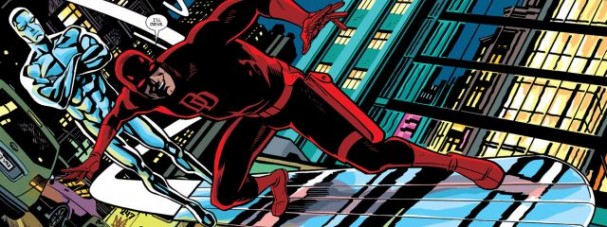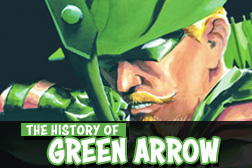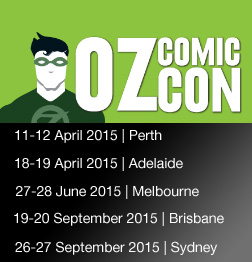Don’t have time for full reviews of comics? Then check out Graphic Bits: bite sized chunks of comic book goodness designed to get behind the panels and into your hearts.
This week (21 August 2013), it’s Infinity crossovers, Trinity wars and Superman punching things really hard. Plus Chin Music (Image Comics) finally gets a second issue! You may also notice this week that we’ve changed our “star” rating system to an easier to read (and easier to aggregate) mark out of 10, often bringing the scores in line with what Richard provides to Newsarama or Comic Book Roundup. This is Graphic Bits.
Avengers Assemble #18 – Marvel, Kelly Sue DeConnick (writer), Barry Kitson (artist). Rating: 6 out of 10
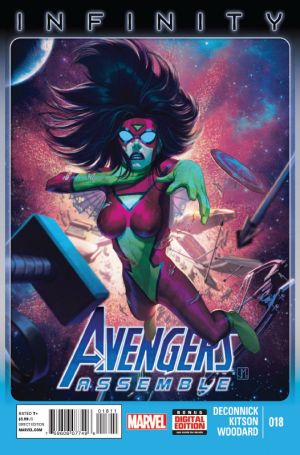 Coming straight off the back of the “The Enemy Within” crossover with Captain Marvel, DeConnick is given no time to breathe before hurtling readers straight into an “Infinity” 2-part tie-in. The transition is not a smooth one: as the Avengers head into space to fight off oncoming forces, one can’t help but feel as though they’ve missed something. Indeed, this is due to not really being able to take this issue in isolation, with Infinity #1 or even this week’s Avengers #18 requiring at least a cursory glance before going any further. More to the point, it is unclear where this fits in with the dramatic ending of DeConnick’s Captain Marvel #14, with the latter appearing to fight alongside the Avengers in this outing. Strangely absent are all the things that make a DeConnick book special: casual interplay between characters, and a much-needed sense of humour in this weighty event. Framing this within Jessica Drew/Spider-Woman’s narration works in the book’s favour, as does Barry Kitson’s clean and bold art. Jay David Ramos and Nolan Woodward’s colours add to this issue’s sense of vivid energy, although it just seems like that energy is misdirected. It will be good to see the Infinity event done so DeConnick can return to her regular programming.
Coming straight off the back of the “The Enemy Within” crossover with Captain Marvel, DeConnick is given no time to breathe before hurtling readers straight into an “Infinity” 2-part tie-in. The transition is not a smooth one: as the Avengers head into space to fight off oncoming forces, one can’t help but feel as though they’ve missed something. Indeed, this is due to not really being able to take this issue in isolation, with Infinity #1 or even this week’s Avengers #18 requiring at least a cursory glance before going any further. More to the point, it is unclear where this fits in with the dramatic ending of DeConnick’s Captain Marvel #14, with the latter appearing to fight alongside the Avengers in this outing. Strangely absent are all the things that make a DeConnick book special: casual interplay between characters, and a much-needed sense of humour in this weighty event. Framing this within Jessica Drew/Spider-Woman’s narration works in the book’s favour, as does Barry Kitson’s clean and bold art. Jay David Ramos and Nolan Woodward’s colours add to this issue’s sense of vivid energy, although it just seems like that energy is misdirected. It will be good to see the Infinity event done so DeConnick can return to her regular programming.
The Bounce #4 – Image Comics, Joe Casey (writer), David Messina (artist). Rating: 5 out of 10
 Much like Joe Casey’s other ongoing title Sex, a fair whack of momentum has been lost since the promising opening issue. Taking it’s slacker hero’s ethos a little too much to heart, the book is content to just exist from page to page, and there’s never a sense that there is a greater plan here. Last month, we commented that the book was yet to find its indentity, but was keeping us on our toes with our inability to predict what would happen next. Unfortunately, this has translated into a lack of focus. There is a sense that this is building to something, as all monthly books should do, but the presence of several big bads confuse the issue. Casey’s tongue seems firmly planted in cheek, as per usual, it’s just that we’re not sure we’re in on the joke yet. Messina’s normally meticulous and lived-in art is starting to show a few signs of being rushed. Ending on yet another cliffhanger, it is getting difficult to continually convince ourselves that the payoff will be worth a few months of water-treading frustrations. The Bounce began as, and remains, an intriguiging concept worth pursuing, but we can only follow it so far. It will be interesting to see if this arc begins to lead us somewhere next month.
Much like Joe Casey’s other ongoing title Sex, a fair whack of momentum has been lost since the promising opening issue. Taking it’s slacker hero’s ethos a little too much to heart, the book is content to just exist from page to page, and there’s never a sense that there is a greater plan here. Last month, we commented that the book was yet to find its indentity, but was keeping us on our toes with our inability to predict what would happen next. Unfortunately, this has translated into a lack of focus. There is a sense that this is building to something, as all monthly books should do, but the presence of several big bads confuse the issue. Casey’s tongue seems firmly planted in cheek, as per usual, it’s just that we’re not sure we’re in on the joke yet. Messina’s normally meticulous and lived-in art is starting to show a few signs of being rushed. Ending on yet another cliffhanger, it is getting difficult to continually convince ourselves that the payoff will be worth a few months of water-treading frustrations. The Bounce began as, and remains, an intriguiging concept worth pursuing, but we can only follow it so far. It will be interesting to see if this arc begins to lead us somewhere next month.
Chin Music #2 – Image Comics, Steve Niles (writer), Tony Harris (artist). Rating: 8 out of 10
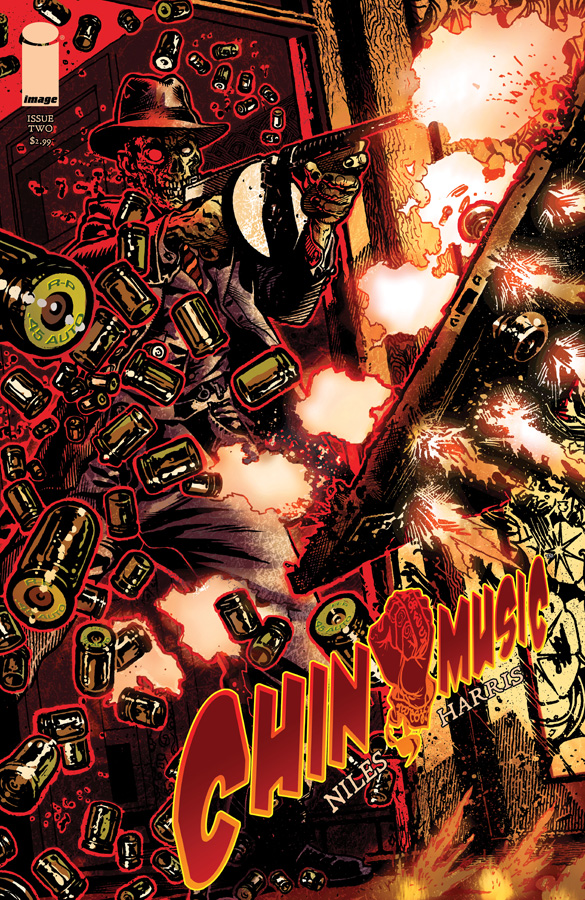 If it seems like a while since the first issue came out, it’s because Chin Music #1 came out all the way back in May. Such a huge delay between the first and second issue would normally be a cause for concern, but the plethora of ideas and beautiful art from the debut issue made the wait seem worthwhile. A supernatural spin on the familiar yarn of gangster Al Capone and Federal Agent Elliot Ness, things took a turn for the unexpected in the first issue when Capone lost his head. This is, of course, not the end of the story. Despite the presence of horror maestro Niles, Harris makes this an art-driven book, cramming every page full of a delightfully twisted sense of the macabre. His Art Deco framing techniques are even bolder in this issue, and the stickiness of red is positively oozing out of those borders. Perhaps the only problem with this approach is that there is too much going on at once, almost as if the last three months worth of stories have all been crammed together in a single outing. It’s not too big of a problem, because the story we have is brimming with hard boiled thrills. Niles has now given us any number of threads to follow, not least of which are several that have been dropped somewhere between the first and second issue. This has all the promise of a lengthy ongoing series for Image if the book can maintain this standard going forward. It’s just crazy enough to work.
If it seems like a while since the first issue came out, it’s because Chin Music #1 came out all the way back in May. Such a huge delay between the first and second issue would normally be a cause for concern, but the plethora of ideas and beautiful art from the debut issue made the wait seem worthwhile. A supernatural spin on the familiar yarn of gangster Al Capone and Federal Agent Elliot Ness, things took a turn for the unexpected in the first issue when Capone lost his head. This is, of course, not the end of the story. Despite the presence of horror maestro Niles, Harris makes this an art-driven book, cramming every page full of a delightfully twisted sense of the macabre. His Art Deco framing techniques are even bolder in this issue, and the stickiness of red is positively oozing out of those borders. Perhaps the only problem with this approach is that there is too much going on at once, almost as if the last three months worth of stories have all been crammed together in a single outing. It’s not too big of a problem, because the story we have is brimming with hard boiled thrills. Niles has now given us any number of threads to follow, not least of which are several that have been dropped somewhere between the first and second issue. This has all the promise of a lengthy ongoing series for Image if the book can maintain this standard going forward. It’s just crazy enough to work.
Daredevil #30 – Marvel, Mark Waid (writer), Javier Rodriguez, Alvaro Lopez (artists). Rating: 9 out of 10
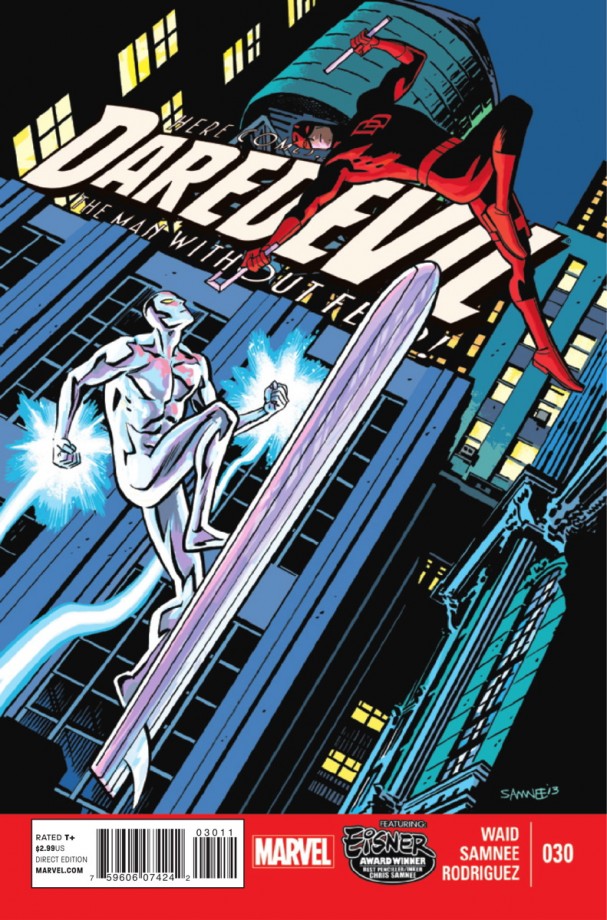 For any other street-level title, the introduction of the Silver Surfer and an alien con man would be evidence of shark jumping. Yet in the multiple Eisner Awarding-winning Daredevil, it’s just another smooth transition from one brilliant story arc to the next. Having already pulled the rug out from under us in exposing a vast network of corruption across Matt Murdock’s justice system, Mark Waid takes us cosmic this month, which is par for the course across Marvel at the moment. It’s to Waid’s eternal credit that it still feels completely part of his flawless run of comics that have now been running for well over two years. Javier Rodriguez continues to be an ideal replacement for Chris Samnee, having been the colourist for Samnee’s run and provided much of the character seen in the art. Every issue offers something a little bit different, and this one is no exception, drawing parallels between Matt’s “radar sense” and the way that the Silver Surfer “sees” the world. Of course, the coolest moment in comics this week comes in seeing Daredevil riding Silver Surfer’s board across New York. It’s moments like this that remind us of why we love comics so much.
For any other street-level title, the introduction of the Silver Surfer and an alien con man would be evidence of shark jumping. Yet in the multiple Eisner Awarding-winning Daredevil, it’s just another smooth transition from one brilliant story arc to the next. Having already pulled the rug out from under us in exposing a vast network of corruption across Matt Murdock’s justice system, Mark Waid takes us cosmic this month, which is par for the course across Marvel at the moment. It’s to Waid’s eternal credit that it still feels completely part of his flawless run of comics that have now been running for well over two years. Javier Rodriguez continues to be an ideal replacement for Chris Samnee, having been the colourist for Samnee’s run and provided much of the character seen in the art. Every issue offers something a little bit different, and this one is no exception, drawing parallels between Matt’s “radar sense” and the way that the Silver Surfer “sees” the world. Of course, the coolest moment in comics this week comes in seeing Daredevil riding Silver Surfer’s board across New York. It’s moments like this that remind us of why we love comics so much.
Justice League Dark #23 – DC Comics, Jeff Lemire (writer) Mikel Janin, Jeromy Cox (artists). Rating: 8 out of 10
 It’s really easy to target all of DC’s mistakes and stumbles over the last two years, but when they get it right, it’s really worth tipping one’s hat to them. Geoff Johns and Jeff Lemire have managed to give a sense of cohesiveness to their Justice League titles, so it’s no surprise that in this penultimate issue of “Trinity War”, Lemire cuts loose and watches the sparks fly. It’s a super version of hot potato as Pandora’s Box gets passed from one cape to the next, yet is still filled with a whole lot of plot twists that belie the action packed front. Indeed, the ending is a twist that will send people flocking to online encyclopaedias, and then ticking off those “Forever Evil” checklists. This event may just be a massive advertisement for the next big thing, but that’s true of all events and this one has been done particularly well. Janin’s art is kinetic, using interesting layouts and vivid colours to carry the action. The few splash pages involving Shazam are frameable. Yet there are still so many loose ends, and with the event officially ending next week in Justice League #23, there are bound to be plenty more crossovers to come. Richard has also written a longer version of this review over at Newsarama.
It’s really easy to target all of DC’s mistakes and stumbles over the last two years, but when they get it right, it’s really worth tipping one’s hat to them. Geoff Johns and Jeff Lemire have managed to give a sense of cohesiveness to their Justice League titles, so it’s no surprise that in this penultimate issue of “Trinity War”, Lemire cuts loose and watches the sparks fly. It’s a super version of hot potato as Pandora’s Box gets passed from one cape to the next, yet is still filled with a whole lot of plot twists that belie the action packed front. Indeed, the ending is a twist that will send people flocking to online encyclopaedias, and then ticking off those “Forever Evil” checklists. This event may just be a massive advertisement for the next big thing, but that’s true of all events and this one has been done particularly well. Janin’s art is kinetic, using interesting layouts and vivid colours to carry the action. The few splash pages involving Shazam are frameable. Yet there are still so many loose ends, and with the event officially ending next week in Justice League #23, there are bound to be plenty more crossovers to come. Richard has also written a longer version of this review over at Newsarama.
Superman Unchained #2 – DC Comics, Scott Snyder, (writer), Jim Lee (artist). Rating: 6 out of 10
 Scott Snyder may have set the world on fire with his definitive spin on Batman, but the same can not be said of Superman Unchained just yet. It begins with the kind of super-powered smackdown that have become commonplace over the last 75 years of Superman’s history, between Superman and the government stooge Wraith (not to be confused with the ‘Brown Batman’ of the 1980s. Snyder’s point of difference is in questioning Superman’s place in an interconnected world, going so far as to level accusations of cowardice at him for not standing up to despots around the globe and instead focusing on the smaller villains. In the 1970s, the liberal left (via characters like Green Arrow) was arguing the opposite of the conservative Superman, and a decade later Frank Miller was flat-out calling him a fascist. Jim Lee’s artwork feels inconsistent and at times rushed, although it is still solid mainstream style that is sure to have its fans. It is still possible to tell a great Superman story, even after all these years, but this particular run is yet to distinguish itself from the thousands of comic books that have hit the stands since 1938.
Scott Snyder may have set the world on fire with his definitive spin on Batman, but the same can not be said of Superman Unchained just yet. It begins with the kind of super-powered smackdown that have become commonplace over the last 75 years of Superman’s history, between Superman and the government stooge Wraith (not to be confused with the ‘Brown Batman’ of the 1980s. Snyder’s point of difference is in questioning Superman’s place in an interconnected world, going so far as to level accusations of cowardice at him for not standing up to despots around the globe and instead focusing on the smaller villains. In the 1970s, the liberal left (via characters like Green Arrow) was arguing the opposite of the conservative Superman, and a decade later Frank Miller was flat-out calling him a fascist. Jim Lee’s artwork feels inconsistent and at times rushed, although it is still solid mainstream style that is sure to have its fans. It is still possible to tell a great Superman story, even after all these years, but this particular run is yet to distinguish itself from the thousands of comic books that have hit the stands since 1938.
Agree or disagree? Got a comment? Start a conversation below, or take it with you on Behind the Panel’s Facebook and Twitter!
If you are an iTunes user, subscribe to our weekly podcast free here and please leave us feedback.

